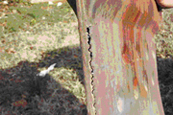
Probably the best is to visually locate a crack. However, particularly in modern 80 percent and 90 percent forced air furnaces, a thorough visual inspection is time consuming and difficult at best.
In the past there have been many suggested techniques. These include:
• A smoke bomb test - a smoke generator is placed in the heat exchanger, then the outside of the heat exchanger is visually accessed to watch for smoke passing through the crack.
• The wintergreen test - oil of wintergreen is sprayed into the combustion chamber (with the blower operating), then see if the smell is present at the supply registers.
• The salt test - a salt solution is sprayed into the combustion chamber, a hole is drilled in the supply ducting, and a torch is held in the air blowing out of the hole to see if the flame changes color from the salt.
• The pressure test - all openings in the heat exchanger are sealed, the blower energized, and a pressure sensor or draft gauge is inserted inside the heat exchanger to see if a crack is allowing distribution air to blow into the heat exchanger (through a crack or hole).
• The tracer gas test - all openings in the heat exchanger are sealed, a methane tracer gas is injected into the heat exchanger, and a combustible gas leak detector passed around the outside looking for areas where the tracer gas is escaping.
• The flame distortion test - watch the flame when the blower comes on and watch for the flame color, shape, etc., to change.

• Leakage is going to be from the flame side to the distribution side of the heat exchanger. This may be the case if the blower is not on and the vent system is not drafting; however, when the blower is on, for example, there is very little chance flue gases, smoke, etc., are going to pass through a crack into the distribution air. When a blower energizes, there is a tremendous amount of pressure around the outside of the heat exchanger; therefore, there is a much greater chance of distribution air being blown into the fire side of the heat exchanger.
• The crack is open when the heat exchanger metal is at (or close to) room temperature. Some cracks have been known to only open when the unit is fired and the heat exchanger metal is hot.
• The service technician has the time, experience, or even reason to suspect the exchanger is cracked.
To test for cracks using a combustion analyzer, simply watch the O2/CO2 readings and the CO reading when the blower comes on - usually several minutes after the burner(s) ignite.
Typically, the O2/CO2 or CO readings will stabilize within 30 to 60 seconds after ignition. If a crack is present, when the blower energizes, air (at 20.9 percent O2) may be blown through the crack in sufficient quantities to raise the O2 (or decrease the CO2) reading on the combustion analyzer.

• It tests under actual operating conditions.
• It may provide additional information as to how dangerous a crack is. For example, if a crack is visually observed and a combustion test finds that when the blower comes on the carbon monoxide reading rises to excessive levels, a service contractor can be more confident that a dangerous situation exists and has the documentation that the unit needs to be immediately condemned and taken out of operation.
• It can be easily done during the normal course of a service call where combustion testing is performed.
It is important to keep in mind that changes in combustion test readings may also be caused by other factors:
• On oil-fired equipment, loose clean out ports in the heat exchanger will most likely result in O2/CO2 or CO readings changing when the blower comes on.
• Depressurization of the mechanical room due to leakage in the return side of the distribution system may be sufficient to change the readings when the blower is energized.
Reprinted with permission from the Training Room page of the Bacharach Inc. Website. Bacharach is a leading manufacturer of testing equipment for air quality, gas detection, HVAC, combustion, and diesel applications. For more information, visit www.bacharach-inc.com.
Publication date:03/19/2007

Report Abusive Comment